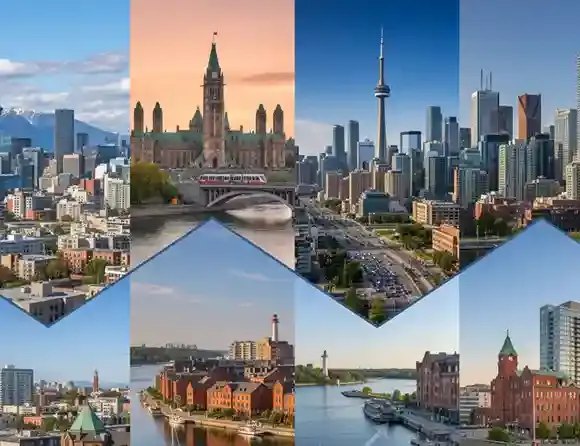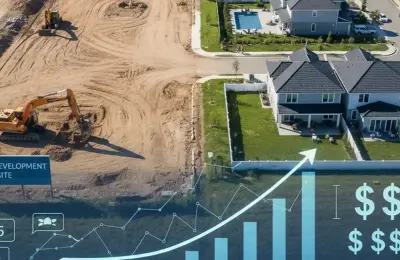
TOP-5 Canadian Cities for Real Estate Investment in 2025-2026: New Opportunities in a Dynamic Market

Calgary and the province of Alberta, in general, are the undisputed leaders in investment attractiveness for the next few years.
- Why Calgary? By continuing to attract a significant influx of residents from more expensive provinces (Ontario and British Columbia), Calgary maintains high rental demand. Relatively lower taxes and competitive housing prices (compared to Toronto) make the investment entry more accessible and the returns higher.
- 2025-2026 Forecast: Expect stable price growth and low vacancy rates in the rental market.
- Investment Niche: Rental-focused properties (duplexes, townhouses) and real estate in commuter cities near Calgary (e.g., Okotoks).
2. Ottawa-Gatineau (Ontario-Quebec): Stability of Civil Service and Technology
As the nation's capital, Ottawa will always remain a stronghold of stability due to the presence of the federal government. This makes investment property in Canada in Ottawa less volatile.
- Why Ottawa? The city's economy is resilient to global downturns, ensuring a constant demand for rental housing from civil servants, students, and high-tech professionals.
- 2025-2026 Forecast: Moderate but stable capitalization, as well as a reliable stream of rental income. Condominium market recovery after a temporary price dip.
- Investment Niche: Condos near universities and in developing areas along the LRT (Light Rail Transit) lines.
3. Halifax, Nova Scotia: The Star of the Atlantic Provinces
Halifax is one of Canada's fastest-growing markets. This seaside city continues to benefit from government programs promoting the Atlantic region and its attractive lifestyle.
- Why Halifax? Significantly lower entry prices than in the "big three" (Toronto, Vancouver, Montreal), a robust student market, and an increasing number of immigrants. It is an ideal location for those seeking growth outside traditionally overheated markets.
- 2025-2026 Forecast: High rental demand and strong housing price growth, albeit at a slower pace than in peak years.
- Investment Niche: Properties near ports and universities (Dalhousie University, Saint Mary's University).
4. Toronto, Ontario: Long-Term Capital Appreciation
While Toronto is the most expensive city to enter, its economic power ensures long-term capitalization. The 2025-2026 period may offer unique opportunities.
- Why Toronto? As a financial hub, Toronto attracts investment into major infrastructure projects and the technology sector. The forecast for declining interest rates could reactivate demand.
- 2025-2026 Forecast: Following a small price dip in 2024, growth is expected to resume, especially in the detached home market (up to 5-7% annually) and stabilization or slow growth in condo prices.
- Investment Niche: Housing in the Greater Toronto Area (GTA), where prices still have significant potential to catch up with the downtown core, as well as condominiums downtown, as their relative affordability may attract first-time buyers.
5. Winnipeg, Manitoba: Affordability and Stable Economy
Winnipeg is often underestimated, but it is one of Canada's most affordable major cities for investment.
- Why Winnipeg? A diversified economy (agriculture, finance, transport) and a steady population increase due to immigration programs. The average home price here is one of the lowest among major cities, ensuring healthy rental yields.
- 2025-2026 Forecast: Moderate price appreciation and attractive cash flow metrics. It is an ideal choice for investors seeking positive cash flow.
- Investment Niche: Rental properties in urban areas with high rental demand, targeting immigrants and middle-income locals.
Remember that the investment property Canada market is complex. Easing interest rates may revitalize the market in 2025-2026, but success requires careful analysis of local data. Always consult with local specialists.
News insight
 Nov 18, 2025
Nov 18, 2025
Property Developer Earnings in the US Market: A Comprehensive Overview
Explore how US property developers earn money. Learn about profit margins (Residential vs. Commercia...
 Nov 18, 2025
Nov 18, 2025
What Is a Build-to-Rent (BTR) Development?
Discover what a Build-to-Rent (BTR) development is. Learn about this growing real estate model, its...
 Nov 17, 2025
Nov 17, 2025
Build-to-Rent: Transforming America's Housing Landscape
Explore how the Build-to-Rent (BTR) model is transforming the US housing market. Learn why instituti...
